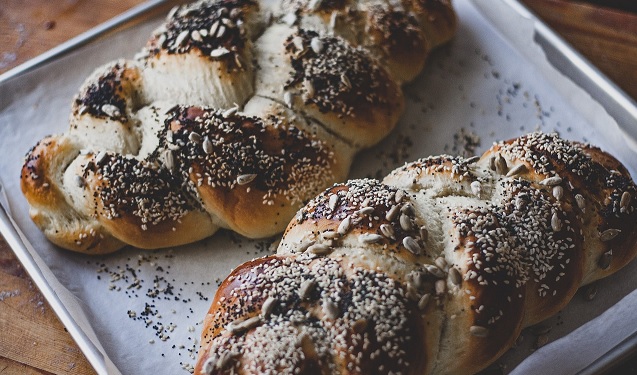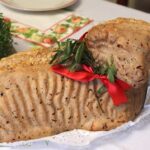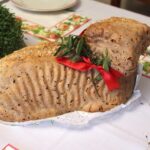
Few things smell as inviting as a freshly baked Hefezopf, the traditional German sweet yeast braid. This light, slightly sweet bread has a delicate, fluffy crumb and a golden-brown crust, making it a favorite for breakfast, brunch, or holiday gatherings.
Hefezopf is often compared to Osterzopf, but unlike the Easter-specific version, Hefezopf is enjoyed year-round in Germany. Some variations include raisins, almonds, or a hint of citrus zest, while others are brushed with butter and sprinkled with pearl sugar for a touch of sweetness.
Whether served with butter, honey, or jam, Hefezopf is a delightful treat that pairs beautifully with coffee or tea. In this guide, we’ll explore its history, cultural significance, and provide a step-by-step recipe so you can bake this delicious bread at home.
History & Cultural Significance
The Origins of Hefezopf
Hefezopf has been a part of German baking traditions for centuries, with roots in Central Europe where sweet yeast breads were common in festive and religious celebrations. The name Hefezopf translates to “yeast braid”, describing its signature woven shape.
Traditionally, Hefezopf is baked for Sundays and special occasions, and in some regions, it is associated with Easter, Christmas, and weddings. The braid is symbolic, representing continuity, family bonds, and prosperity. In some parts of Germany, it is even given as a gift to newlyweds to wish them a sweet and prosperous life together.
Variations exist across Germany and Austria. Some recipes include dried fruit and nuts, while others feature a sugar or streusel topping. Hefezopf remains a staple in German bakeries, where it is often sold in large, beautifully braided loaves.
Want to explore more German bread recipes? Check out our articles on Osterzopf and Classic Swabian Bread Recipe.
Ingredients & Preparation (Step-by-Step Recipe Guide)
Ingredients for Authentic Hefezopf
Dough Ingredients:
- 500g (4 cups) all-purpose flour
- 75g (⅓ cup) sugar
- 1 packet (7g) dry yeast or 25g fresh yeast
- 250ml (1 cup) warm milk
- 80g (⅓ cup) unsalted butter, softened
- 1 egg
- 1 tsp salt
- ½ tsp vanilla extract (optional)
- Zest of 1 lemon (optional)
- 50g (⅓ cup) raisins (optional)
For Brushing & Topping:
- 1 egg yolk, beaten (for glazing)
- 2 tbsp milk
- 2 tbsp pearl sugar or sliced almonds
Substitutes: If you don’t have fresh yeast, use dry yeast (7g = one packet). For added aroma, try adding a pinch of cardamom or cinnamon.
How to Make Hefezopf (Step-by-Step Instructions)
Step 1: Activate the Yeast
- Warm the milk slightly (not too hot).
- Stir in sugar and yeast, let it sit for 5-10 minutes until frothy.
Step 2: Prepare the Dough
- In a large mixing bowl, combine flour, salt, and lemon zest.
- Add the yeast mixture, butter, egg, vanilla extract, and raisins (if using).
- Knead the dough for 10 minutes until smooth and elastic.
Pro Tip: If the dough is sticky, sprinkle in a bit more flour. If it’s dry, add a spoonful of warm milk.
Step 3: Let the Dough Rise
- Cover the dough with a clean towel and let it rise in a warm place for 60-90 minutes until doubled in size.
Step 4: Shape & Braid the Hefezopf
- Divide the dough into three equal pieces and roll them into long strands.
- Braid the strands together and tuck the ends underneath.
- Place the braid on a baking sheet lined with parchment paper.
Step 5: Final Rise & Baking
- Cover and let the dough rise again for 30 minutes.
- Preheat oven to 180°C (350°F).
- Brush the braid with egg yolk mixed with milk and sprinkle with pearl sugar or almonds.
- Bake for 25-30 minutes, or until golden brown.
Serving Suggestions & Variations
How to Serve Hefezopf
Hefezopf is best served fresh and slightly warm with:
- Butter and honey for a traditional German breakfast
- Homemade jam or Nutella for a sweeter option
- Soft cheese or quark for a creamy contrast
Variations & Regional Twists
In Bavaria, Hefezopf is often made with raisins and a hint of rum. In Swabia, it is sometimes topped with streusel for extra sweetness. In Austria, cardamom or cinnamon is added for a spiced aroma.
Want to try another German bread? Check out our Osterkranz (Easter Wreath Bread) recipe.
Baking Hefezopf at home is a wonderful way to enjoy a classic German treat. Its soft, fluffy texture and slightly sweet flavor make it perfect for breakfast, brunch, or any special occasion. Whether you enjoy it plain, with butter, or topped with jam, this braided bread is a delightful addition to any table.
Looking for more traditional German baked goods? Explore our recipes for Osterzopf, Rüblikuchen, and Franzbrötchen.







